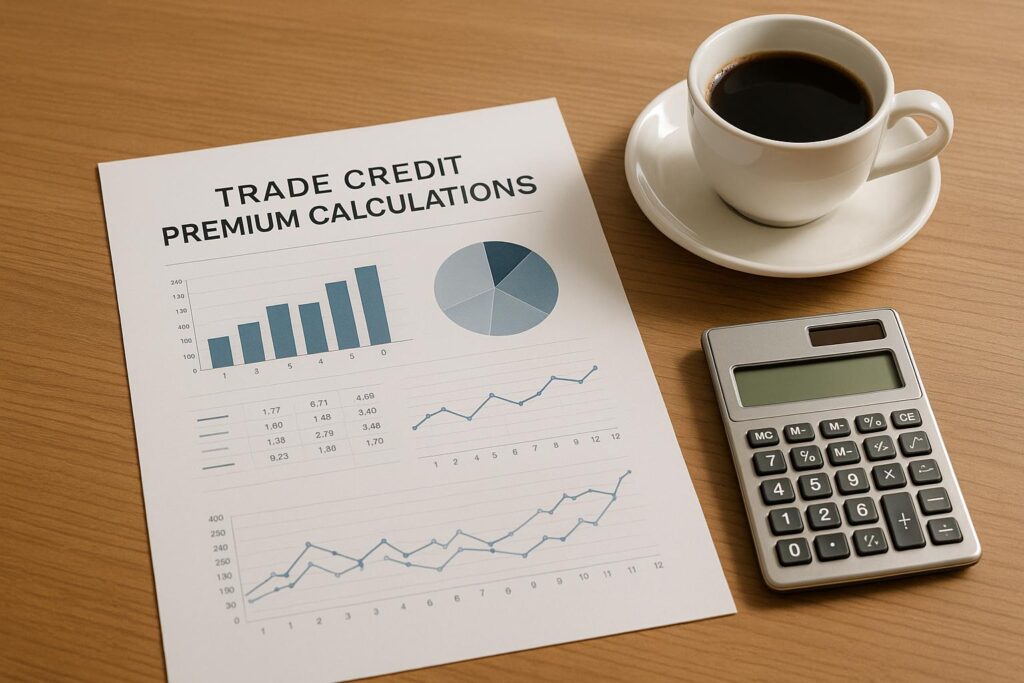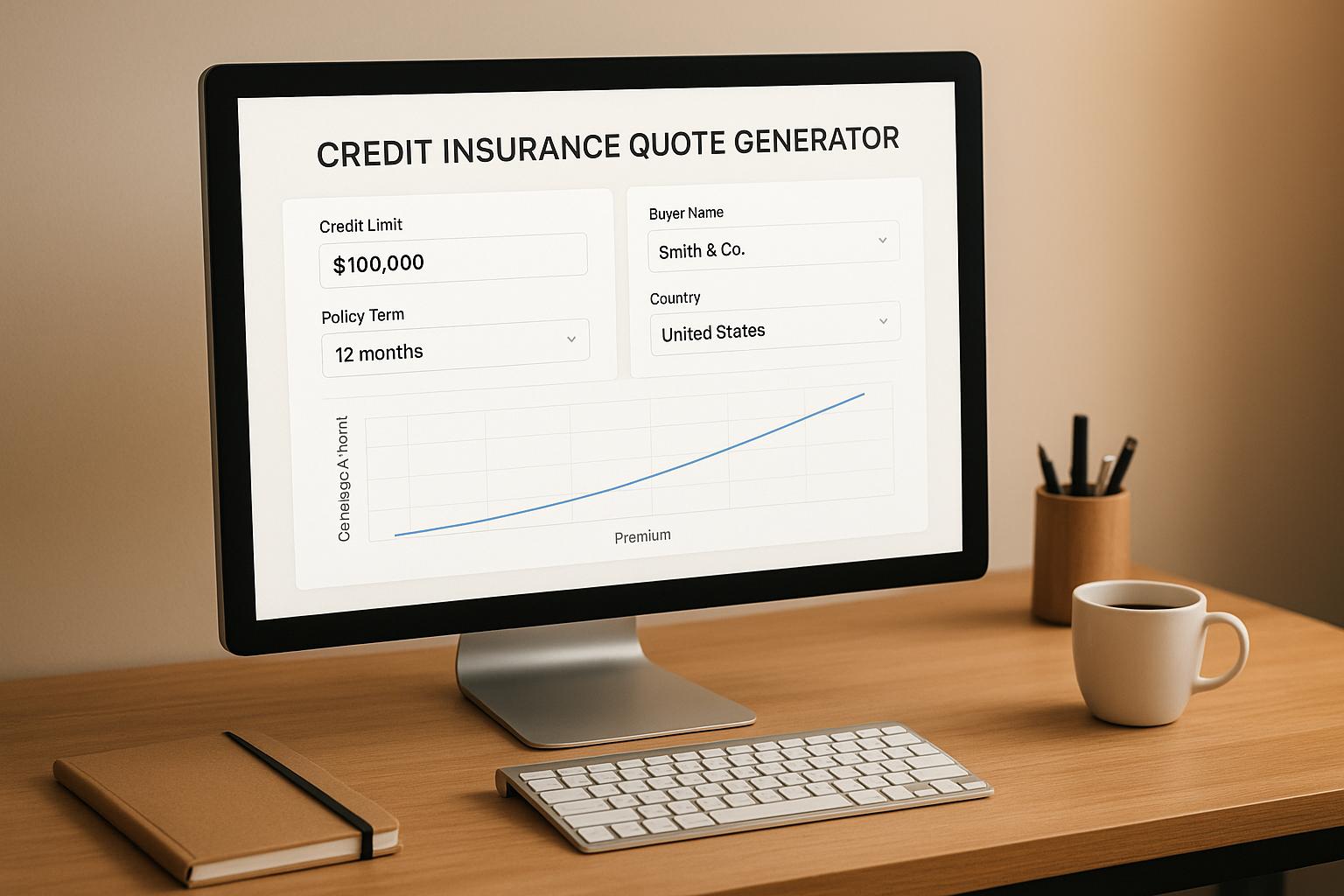Trade credit insurance protects businesses from financial losses due to non-payment, insolvency, or bankruptcy. Calculating premiums for this insurance is vital for balancing costs and ensuring sufficient coverage. Premiums typically range from 0.1% to 0.4% of annual sales, averaging around 0.25%. For example, a company with $20 million in sales might pay less than $50,000 for full coverage.
Key factors influencing premiums include:
- Annual Sales (Insured Turnover): Higher turnover means higher premiums in absolute terms, but rates remain proportional.
- Risk Assessment: Customer creditworthiness, industry type, geographic exposure, and claims history affect costs.
- Policy Structure: Coverage limits, retained risk (deductibles), policy type (whole turnover vs. specific accounts), and credit terms impact pricing.
Modern tools and automation simplify premium calculations, offering real-time updates and better risk tracking. ARI, a leading provider, uses advanced technology and expert brokers to customize policies, manage claims, and ensure competitive rates. Businesses using trade credit insurance often see improved cash flow, reduced risks, and increased growth opportunities.
Factors That Affect Trade Credit Premium Calculations
Trade credit insurance premiums aren’t one-size-fits-all – they’re shaped by a range of risk factors unique to each business. Insurers analyze these elements to assess risk and determine pricing, ensuring policies are tailored to the specific needs of the insured company. By understanding how these factors come into play, you’ll be better prepared to estimate costs and work with your insurer to secure competitive rates. Let’s break down how turnover, risk evaluations, and policy structures influence premium calculations.
Insured Turnover and Sales Volume
The cornerstone of trade credit insurance premiums is your company’s insured turnover. Insurers use this figure to gauge the scale of risk they’re taking on. Premiums are calculated as a percentage of your annual sales volume, typically measured in U.S. dollars. While businesses with higher sales volumes pay more in absolute terms, the percentage rate remains proportional to their revenue. For most companies, premium rates fall between 0.05% and 0.6% of turnover, with 0.2% being a commonly referenced average. It’s worth noting that premiums generally stay below 0.5% of turnover.
Risk Assessment Criteria
Risk assessment plays a critical role in determining premiums, as it helps insurers evaluate the likelihood of claims and adjust policy terms accordingly. Here are the key factors insurers consider:
- Customer Creditworthiness: Insurers examine the financial stability, payment history, and reliability of your trade partners. Credit limits are often based on your customers’ financial health and payment behaviors.
- Business Sector: Some industries are riskier than others due to market volatility, seasonal trends, or sensitivity to economic shifts.
- Loss History: Companies with a clean record of minimal bad debts, timely payments, and few insurance claims typically enjoy lower premiums.
- Geographic Factors: Where you do business matters, especially if you’re exporting. Political stability, infrastructure quality, and potential conflicts in your customers’ regions all weigh into the risk calculation [13, 7].
Interestingly, a poor trade history doesn’t automatically mean higher premiums. Insurers also consider market trends and future demand, which can offset past issues. Once the risk assessment is complete, the structure of your policy further shapes the final premium.
Policy Coverage and Structure
The way your trade credit insurance policy is designed has a direct impact on premium costs. Here are the main elements that come into play:
- Coverage Limits: These set the maximum amount the insurer will pay for losses. While higher limits increase premiums, insurers may offer better rates per dollar as coverage amounts rise.
- Retained Risk: The share of risk your business takes on – through deductibles or co-insurance – affects costs. Opting for a higher deductible can reduce your premium.
- Policy Type: Whole turnover policies, which cover your entire customer base, typically offer lower per-dollar rates than selective coverage for specific accounts or single buyers. On the other hand, transactional coverage for individual deals tends to have higher rates.
- Credit Terms: Longer payment terms for your customers increase the risk of non-payment, which can drive up premiums.
- Percentage of Risk Covered: Most policies cover 80–90% of losses. Choosing a higher coverage percentage raises premiums, while opting for less coverage can help balance costs.
How to Calculate Trade Credit Premiums
Understanding how insurers calculate trade credit premiums can help you budget effectively and secure competitive rates. The methods used depend on factors like your business size, risk profile, and specific coverage needs. These calculations build upon the risk factors we’ve already discussed, setting the foundation for more advanced tools in determining premiums.
Percentage of Insured Turnover
One of the simplest ways insurers calculate premiums is by using the percentage of insured turnover method. Here, they take your annual sales volume and apply a fixed percentage rate to arrive at your premium cost. This approach is popular because it’s straightforward and adjusts naturally with the size of your business.
For example, if your annual insured turnover is $10 million and your insurer applies a rate of 0.25%, your premium would be $25,000. However, the exact percentage can vary depending on factors like your customers’ creditworthiness, the risks associated with your industry, and your loss history.
Formula-Based and Risk-Adjusted Models
For a more tailored approach, insurers often rely on formula-based and risk-adjusted models. These methods incorporate multiple risk variables to refine premium calculations. For instance, they take into account country-specific risks and categorize debtors by their risk levels. If you’re dealing with customers in higher-risk countries, your premium will likely increase to reflect the added exposure. On the other hand, transactions with financially stable customers in low-risk markets may lead to reduced premiums.
These models emphasize the balance between risk and reward: higher risks lead to higher premiums.
Other factors that influence these calculations include your trading history, customer payment behaviors, the credit terms you offer, and your overall geographic exposure. Policy choices also play a role – opting for a higher deductible, for example, can lower your premium since you’re assuming more of the risk.
For businesses operating internationally, these models also factor in currency fluctuations and geographical risks. In the next section, we’ll explore how premium calculation tools integrate these methods to streamline risk assessment.
Tools and Software for Premium Calculations
Modern technology has revolutionized how trade credit premiums are calculated, replacing manual effort with formula-based, risk-adjusted models. These tools not only save time but also improve accuracy.
Features of Premium Calculation Tools
Premium calculation software comes packed with features designed to make the process more efficient and precise. For example, integration with accounting software ensures that receivables data is up-to-date and eliminates the risk of manual entry errors.
Another standout feature is automated risk monitoring, which keeps a constant eye on customers’ creditworthiness and payment habits. If a customer’s credit rating takes a hit, the software flags the change and recalculates the premium automatically.
Customizable reporting is another major benefit. These tools can generate insights tailored to specific industries, assess geographic risks, and analyze customer concentration. Additionally, real-time credit risk alerts keep you informed of potential issues as they arise.
Some advanced tools, like Trade Credit Quantified, go even further. They analyze trade receivables using vast amounts of historical data – 14 million data points, to be exact – combined with current economic trends. This provides a detailed framework that includes risk ratings, default probability forecasts, risk exposure breakdowns, and ROI calculations.
By automating key risk factors, these tools ensure that premium calculations stay aligned with changing risk profiles. ARI further enhances these capabilities through its specialized technological integrations.
ARI‘s Access to Advanced Tools
Accounts Receivable Insurance (ARI) takes advantage of cutting-edge technology through its partnerships with global credit insurance carriers. These partnerships provide access to advanced premium calculation tools powered by AI, which predict customer behavior and simplify the calculation process.
ARI’s tech stack includes modern accounts receivable software that automates tasks like managing invoices, tracking payments, and handling customer communications. This automation not only speeds up collections and boosts cash flow but also influences premium calculations. Considering that accounts receivable often represent about 40% of a company’s total assets, this impact is significant.
With ARI’s tools, businesses gain access to real-time analytics for tracking metrics like Days Sales Outstanding (DSO). These analytics help identify potential issues early on, ensuring timely adjustments to premium calculations. The shift to automation also highlights the stark differences between manual and automated methods.
Manual vs. Automated Calculations
The contrast between manual and automated premium calculations goes beyond just saving time. Manual methods rely heavily on spreadsheets and paperwork, which are not only slow but also prone to errors. Automated systems, on the other hand, deliver fast, accurate results with real-time updates.
| Manual Calculations | Automated Calculations |
|---|---|
| Inefficient processes: Tasks can take hours or days, with a high risk of errors | Fast processing: Instant calculations with real-time updates |
| Static data: Relies on outdated or snapshot information | Dynamic data: Uses real-time credit scores and market conditions |
| Inflexible: Hard to adapt to changing risk factors | Flexible: Automatically adjusts to new variables |
| Manual reviews: Requires periodic checks | Continuous monitoring: Tracks risk factors 24/7 |
Automated systems also excel in evaluating customer financial health. They provide better risk scoring and credit limit recommendations, ensuring premiums are aligned with actual risk exposure. This is especially useful when managing complex scenarios like multi-currency transactions, international clients, or varying payment terms. The result? A more streamlined, accurate, and responsive approach to premium calculations.
sbb-itb-2d170b0
Best Practices for Accurate Premium Calculations
Getting premium calculations right means relying on clean data, staying on top of risk assessments, and working with experienced insurance professionals. These strategies ensure your trade credit insurance aligns with your business needs while keeping costs in check.
Keep Receivables Data Up-to-Date
Accurate accounts receivable data is the backbone of precise premium calculations. Outdated or incomplete customer information can cause missteps, leading to inflated premiums or gaps in coverage.
To avoid this, review your customer data every quarter and standardize credit applications for all new clients. This ensures that invoices and payment reminders are sent to the right contacts, improving collection rates and refining your risk profile. For example, one supplier saw a 20% drop in default losses after incorporating updated regional market insights.
Be diligent about documenting key details like billing periods, invoicing dates, and all necessary information on invoices. Automation tools can help maintain accuracy and reduce manual errors. Additionally, conduct periodic reviews of credit limits for long-term customers. This allows you to adjust terms as business relationships and financial conditions change, keeping your credit terms relevant and effective.
Perform Regular Risk Assessments
Frequent risk assessments help you stay agile in response to economic, political, and regulatory shifts. Update your credit scoring models regularly with the latest financial data, market trends, and geopolitical developments. For instance, an agricultural exporter operating in multiple developing economies found that revising their risk models helped them secure better premium rates.
Using automated systems that provide real-time updates on buyer behavior can further enhance your risk management. Regular assessments also make it easier to negotiate flexible policy terms that align with your business cycles and seasonal demands. Staying informed about market and regulatory changes ensures your strategies remain relevant and your risk profiles accurately reflect the current environment.
Collaborate with Expert Brokers
While automation and accurate data are critical, expert guidance adds another layer of precision to your premium strategy. Managing trade credit insurance across different markets, currencies, and regulations can be challenging, but experienced brokers can simplify this process.
ARI’s expert brokers, known for their advanced technological resources, specialize in optimizing policies to suit unique business risks. They can negotiate terms that align with your operational needs and recommend digital tools to enhance credit risk evaluations. Beyond setting up your policy, ARI’s brokers provide ongoing support for adjustments, claims management, and premium optimization as your business evolves. By acting as a bridge between you and insurers, they ensure that everyone involved understands the risk factors and coverage requirements that influence premium calculations. Their expertise can save you time, reduce complexity, and help you make informed decisions.
Conclusion and Key Takeaways
Grasping how trade credit premiums are calculated is key to shielding your business from financial risks while staying competitive. The steady growth of the global trade credit insurance market underscores how businesses are increasingly valuing this type of protection.
Premium Calculation Basics
Several factors influence trade credit premiums, directly affecting your costs. Elements like turnover size, buyer risk profiles, industry type, credit terms, and buyer locations all play a role in determining the final premium rate. On the bright side, premiums often remain below 0.5% of a company’s turnover, making this a budget-friendly way to safeguard your business.
If your business handles higher sales volumes or operates with shorter payment terms, you’re likely to pay lower premium rates. On the other hand, companies in risk-heavy industries or those exporting to unstable regions should anticipate higher costs. By understanding these factors, you can make smarter choices about your coverage and policy design.
Premium calculations range from straightforward percentage models to more complex, risk-adjusted formulas that incorporate dynamic credit scoring. While modern tools automate much of the process, the accuracy of your data is critical for reliable results. These principles are at the core of how ARI customizes its solutions to protect businesses.
How ARI Supports Businesses
ARI takes trade credit insurance to another level. Their database tracks over 85 million companies, and they process 85% of credit limit requests in under 48 hours, providing the speed and precision that businesses need.
Their solutions empower businesses to close larger deals and expedite credit decisions. For instance, in March 2023, Mike Libasci, President of International Fleet Sales, used accounts receivable insurance to handle larger, previously risky transactions, boosting profitability. Similarly, in January 2024, Hadco‘s CFO Ori Ben-Amotz leveraged ARI’s services to speed up credit decisions, helping the company expand its market share in a fast-moving industry.
"Accounts receivable insurance has allowed us to take on customers and transactions we wouldn’t have felt comfortable taking on by ourselves. It has not only allowed my company to take on larger deals, but be more liberal in terms, and the result has gone straight to our bottom line." – Mike Libasci, President, International Fleet Sales
ARI’s brokers provide ongoing support for adjusting policies, managing claims, and fine-tuning premiums as your business evolves. Their expertise and advanced tools help businesses navigate complex markets and regulations while securing the best terms. These services not only optimize premiums but also strengthen financial resilience.
Managing Trade Credit Risk
Competitive premium rates are just one piece of the puzzle – effective risk management is equally important. It starts with accurate premium calculations and extends to continuously refining your policy. Businesses with trade credit insurance often see sales growth of up to 20%, and banks are more likely to lend – offering up to 80% more on insured receivables. The industry’s strong performance is evident in its average net combined ratio of 78% since 2015, even during periods of financial instability. Insured firms are also better positioned during economic downturns, with only 19% reporting negative impacts compared to 33% of uninsured businesses.
The key to managing trade credit risk lies in maintaining accurate receivables data, conducting regular risk checks, and collaborating with seasoned professionals. As Cathy Jimenez, Credit Manager at Del Campo, explains:
"I tell them there is a cost, but it’s easily offset by what you get. When you think about the benefits and what you could lose if a customer went bankrupt or just failed to pay, the cost of credit insurance balances out. I strongly recommend it." – Cathy Jimenez, Credit Manager, Del Campo
Incorporating trade credit insurance into your broader risk management strategy involves assessing your customer base, industry risks, and credit practices. Choose coverage that aligns with your specific needs, taking into account coverage percentages, premium rates, and policy terms. Safeguarding your accounts receivable isn’t just a smart move – it’s essential for ensuring long-term financial stability.
FAQs
How do trade credit insurance premiums differ by industry and region?
Trade credit insurance premiums can differ significantly based on the industry and location. Several factors come into play, such as the risk level tied to a particular industry, the state of the local economy, the volume of trade, and the regulatory landscape. For instance, industries like construction or retail, which often carry higher risks of default, typically have steeper premiums compared to more stable sectors like healthcare or utilities.
In the U.S., regional economic conditions also play a big role in determining premiums. Areas with economic instability or higher rates of business insolvency tend to have higher premium costs. These variations ensure that policies are designed to address the specific risks businesses encounter, offering tailored protection for their trade credit and accounts receivable.
How does technology improve the accuracy and efficiency of trade credit premium calculations?
Technology has transformed how trade credit premium calculations are handled, making the process faster, more accurate, and less prone to errors. Tools like AI, blockchain, and data analytics allow businesses to process large volumes of data quickly, ensuring precise and dependable results.
With these advancements, companies can make smarter decisions, cut down on administrative tasks, and run their trade credit policies more efficiently. This approach not only saves valuable time but also equips businesses to respond to shifting market conditions with ease and confidence.
What steps can businesses take to secure the best rates for trade credit insurance premiums?
To get the best rates on trade credit insurance premiums, businesses can take several smart steps:
- Partner with skilled brokers who have expertise in trade credit insurance. They can guide you through your options and handle negotiations to secure favorable terms.
- Gather and compare quotes from multiple trusted insurers to identify the best deal that fits your business needs.
- Keep your credit practices in top shape by ensuring timely invoicing and staying proactive with debt collection. This reduces the risk profile for insurers.
- Regularly review your policy to confirm it still matches your current operations and market conditions.
Working with insurers who provide customized coverage and thorough risk evaluations can also help you manage costs effectively while safeguarding your accounts receivable.




